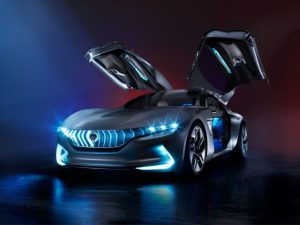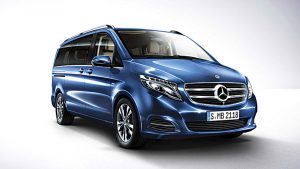
One of the stars of the recent Geneva Motor Show was the HK GT, penned by the legendary Turin-based styling house Pininfarina. Another was the Sibylla electric sedan. It was the work of GFG Style, with “GFG” standing for the famous father and son combo, Giorgetto and Fabrizio Giugiaro.
Italdesign was also at Geneva, with the spectacular $US1.6 million ($2.1 million) Zerouno Duerta Roadster, and several other companies reinforced there’s a whole new energy among Italian design houses.
It follows a couple of lean decades in which many major manufacturers set up their own studios and brought design completely inhouse.
What has changed recently is China. It is now the world’s largest vehicle market and its new car makers, or would-be car makers, don’t tend to have broad skills. Many specialise in areas such as batteries or software and need people to turn their vision and technology into workable, desirable cars.
The Italians are on to it.
Years of difficulty
The Sibylla was produced with China’s Envision Energy company. Pininfarina‘s HK GT – with an electric motor in each wheel delivering a massive 800kW total – was produced on behalf of Hybrid Kinetic Group, a technology concern from Hong Kong. An earlier Pininfarina-Hybrid Kinetic Group concept is now on the cusp of series production.
“We have gone through years of difficulty but we have reversed the trend and the future is looking very nice,” Pininfarina director general Silvio Pietro Angori tells us. “The brand is still very well known.”

Pininfarina was set up in 1930 as acarrozzeria (body builder), making extravagant coupes and roadsters for wealthy clients. It is best known for penning a string of beautiful Ferraris from the 1950s. The company is now decidedly cosmopolitan, employing 680 people in half a dozen sites, mainly in Italy and China. An Indian company, Mahindra, is its chief shareholder.
Angori says it is not just Pininfarina that has changed but design itself.
“Any good design these days is not meant to be for just one single user but as part of a mobility service. So design is going to shape the customer experience you want to offer your clients … you want to design the entire process that brings a client to use this car, and in doing so you have to be coherent and consistent with the image and the language you want to transmit.”
Angori pulls out his smartphone. “One million [smartphones] are sold a day, but each one is personalised. The moment you switch it on, you put whatever you wish there. This is the same thing you would like to have for a [shared] car. The moment you get in you would like to have the colours you are used to, the seating arrangement you like, your music. This is where the challenge is and where our designers have to focus.”

All car makers, including new ones, have a range of values that matter to them, he says. “We would then translate that set of values into something that makes sense in a different field. This is how we translate a vision into a design.”
Another car of the future fully designed and engineered in Turin is the LVCHI Venere. The electric limousine will be built there from next year. Once again, it is part of a joint venture, with Chinese entrepreneurial company LVCHI relying heavily on Italy’s I.DE.A Institute.
Domenico Morali, the CEO of LVCHI’s Innovation Centre in Turin, says Italian expertise has allowed the Chinese to put their ideas into production more quickly, with “a reliable and affordable performance”.
“We have in development a city car as well that will use the same technology but in a different scale, and this city car will go into production in China next year. It is a two-seater … [that will be followed by] a four-seater, which is 300mm longer.”

Morali says the $US400,000-plus Venere will be pitched against the Maserati Quattroporte, Porsche Panamera and Aston Martin Rapide. The body will be made entirely of carbon fibre. The claim is the vehicle will have a 652-kilometre range and the ability to sprint to 100km/h in the supercar-like time of 2.5 seconds.
Icona is another Italian automotive design house that struggled during the GFC then switched its focus to China and saw things improve rapidly. It now bases 80 of its 120 employees in Shanghai.
Spokesman Raffaello Porro says Icona has worked with almost all the big Chinese car makers, including Geely, Brilliance and FAW, and is now starting to work for American and European customers.
Its latest concept vehicle is the Icona Nucleus robotaxi. It’s a luxurious six-passenger shuttle, with no steering wheel or pedals, and a claimed 1200km range thanks to a fuel cell range extender. “There are the financial resources to make it real in two or three years,” says Porro. “But it needs infrastructure and regulatory changes to make that happen.”

Beautiful mistakes
Matt Hill, head of interior design at Aston Martin, had a stint at Ghia in Turin when it was owned by Ford. The Englishman was able to observe the Italian process and identify some reasons for its success: “Flamboyance, passion, free-thinking. Certain areas of the world are not shackled by overthinking, maybe, and that seems to come out in Italian design. They feel it more. They don’t analyse as much, which means they make mistakes, but they seem to become charming, beautiful mistakes.”
Hill points out the Italians also have a long tradition of classical training. “The draftsmanship is still important. Proportions have always been important to Italians. Maybe their industry has gone through a bit of turmoil but they haven’t stopped being creative. They have talent and will travel and are employed around the world, so I guess [their resurgence] is not surprising.”

Professional freelancer and webmaster.


























+ There are no comments
Add yours